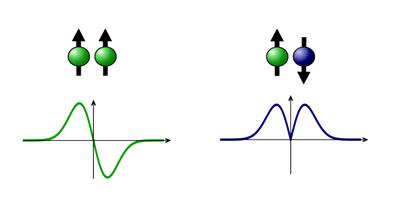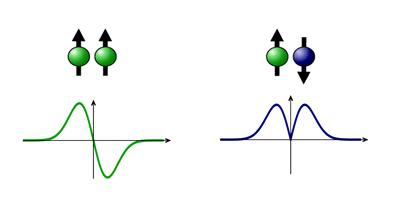Fermionic Switch
Whether particles in a many-body quantum system are bosons or fermions determines its fundamental properties. For identical fermions, the probability to occupy the same point in space has to vanish. However, simulating the emergence of this effect is challenging, since the fermionic nature of a particle can’t be slowly turned on. Now, a group in Germany has designed a cold-atom experiment where they can adjust the interactions between two distinguishable fermions so they mimic identical fermions.
Gerhard Zürn and his colleagues at Heidelberg University prepared two experiments in which an optical potential confined a pair of fermionic lithium- atoms in a long, cigar-shaped volume. In one experiment, the atoms were identical; in the other, the two atoms had opposite spin. The group used an external magnetic field to tune the interaction strength between the distinguishable atoms, but this field had no effect on the identical fermions.
A quirk of this one-dimensional system is that if both two-particle systems have the same energy, they must be described by the same spatial probability distribution. The authors determined the energy of each two-particle system by creating a “leak” in the optical potential and measuring the rate at which a particle tunneled out. By tuning the repulsive interaction between the distinguishable atoms, Zürn et al. were able to bring this system to a point where the probability that the particles overlap is zero, as for two identical fermions.
The ability to simulate the wave function of identical fermions in a two-particle system such as this could eventually allow the study of more complex many-bodied quantum systems. – Jessica Thomas





